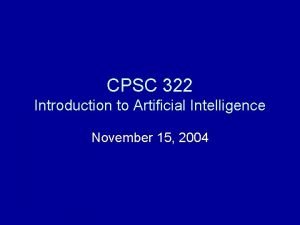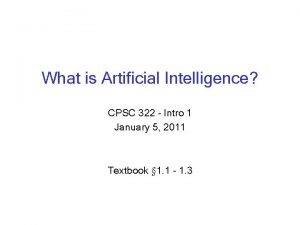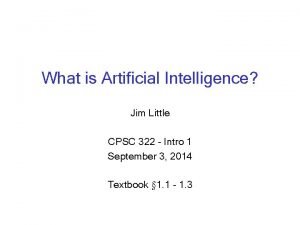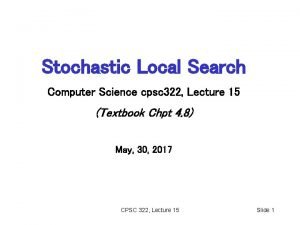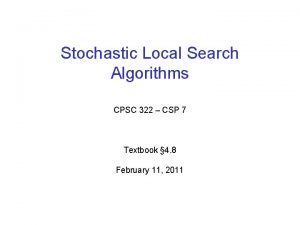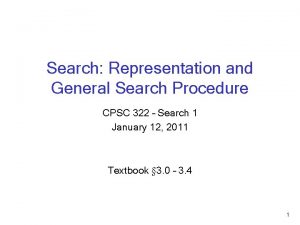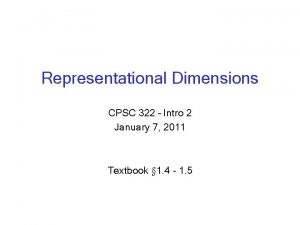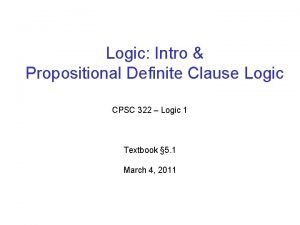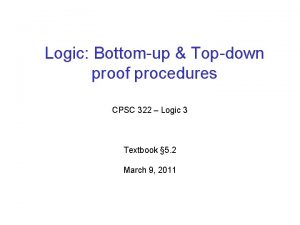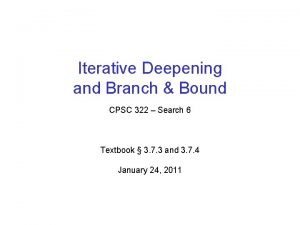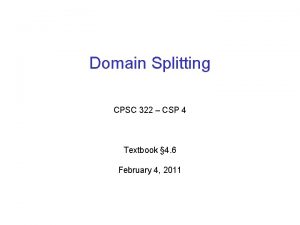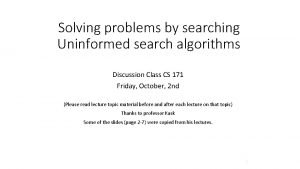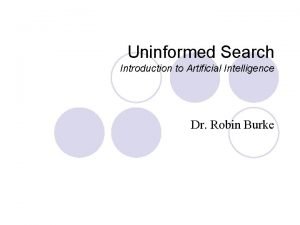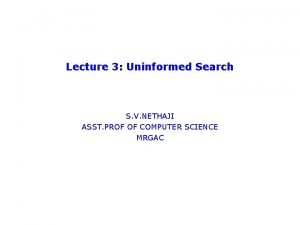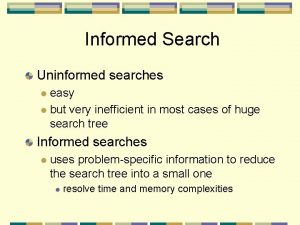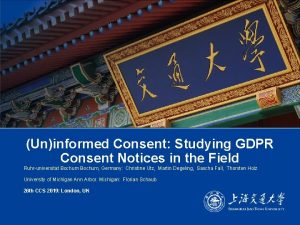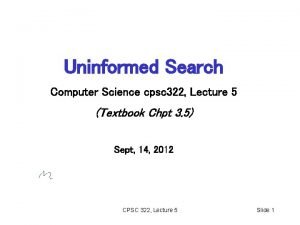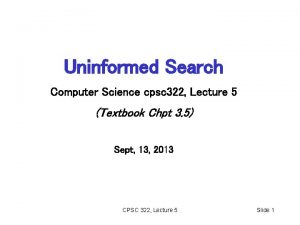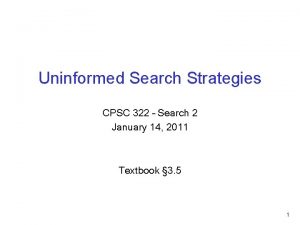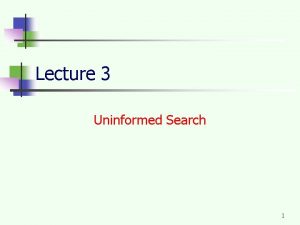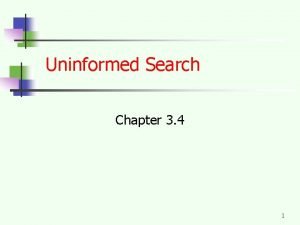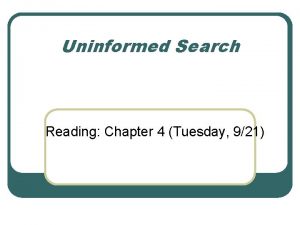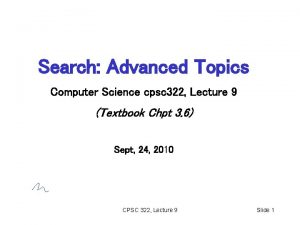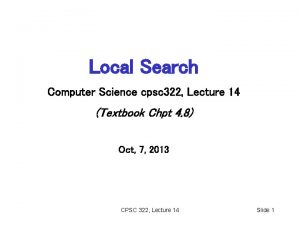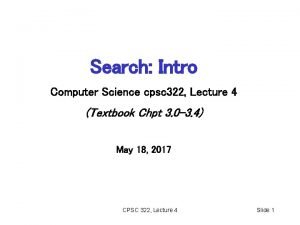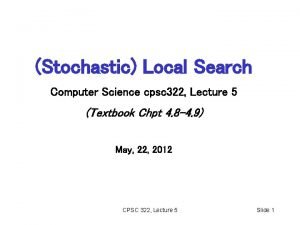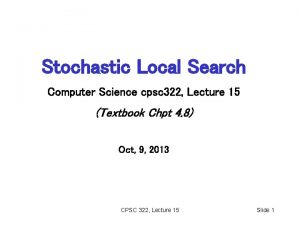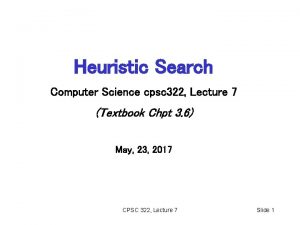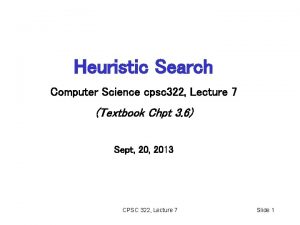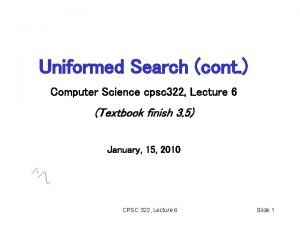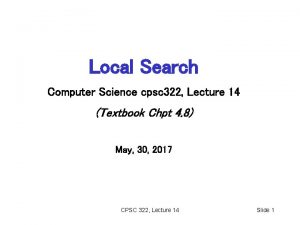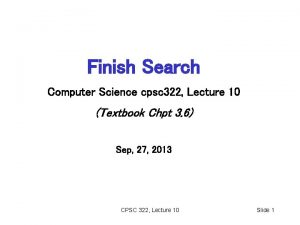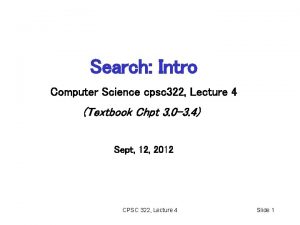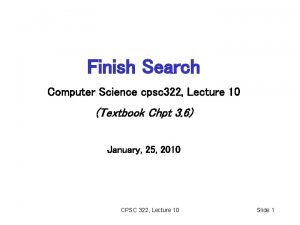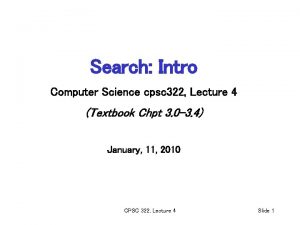Uninformed Search Computer Science cpsc 322 Lecture 5






















- Slides: 22

Uninformed Search Computer Science cpsc 322, Lecture 5 (Textbook Chpt 3. 5) January, 13, 2010 CPSC 322, Lecture 5 Slide 1

Office Hours • Giuseppe Carenini ( carenini@cs. ubc. ca; office CICSR 129) Teaching Assistants • Hammad Ali hammada@cs. ubc. ca • Kenneth Alton kalton@cs. ubc. ca (will be starting Jan 18) • Scott Helmer shelmer@cs. ubc. ca • Sunjeet Singh sstatla@cs. ubc. ca CPSC 322, Lecture 1 Slide 2

Recap • Search is a key computational mechanism in many AI agents • We will study the basic principles of search on the simple deterministic planning agent model Generic search approach: • define a search space graph, • start from current state, • incrementally explore paths from current state until goal state is reached. CPSC 322, Lecture 4 Slide 3

Searching: Graph Search Algorithm with three bugs Input: a graph, a start node, Boolean procedure goal(n) that tests if n is a goal node. frontier : = { g : g is a goal node }; while frontier is not empty: select and remove path n 0, n 1, …, nk from frontier; if goal(nk) return nk ; for every neighbor n of nk add n 0, n 1, …, nk to frontier; end while • The goal function defines what is a solution. • The neighbor relationship defines the graph. • Which path is selected from the frontier defines the search strategy. CPSC 322, Lecture 5 Slide 4

Lecture Overview • Recap • Criteria to compare Search Strategies • Simple (Uninformed) Search Strategies • Depth First • Breadth First CPSC 322, Lecture 5 Slide 5

Comparing Searching Algorithms: will it find a solution? the best one? Def. (complete): A search algorithm is complete if, whenever at least one solution exists, the algorithm is guaranteed to find a solution within a finite amount of time. Def. (optimal): A search algorithm is optimal if, when it finds a solution , it is the best solution CPSC 322, Lecture 5 Slide 6

Comparing Searching Algorithms: Complexity Def. (time complexity) The time complexity of a search algorithm is an expression for the worst-case amount of time it will take to run, • expressed in terms of the maximum path length m and the maximum branching factor b. Def. (space complexity) : The space complexity of a search algorithm is an expression for the worst-case amount of memory that the algorithm will use (number of nodes), • Also expressed in terms of m and b. CPSC 322, Lecture 5 Slide 7

Lecture Overview • Recap • Criteria to compare Search Strategies • Simple (Uninformed) Search Strategies • Depth First • Breadth First CPSC 322, Lecture 5 Slide 8

Depth-first Search: DFS • Depth-first search treats the frontier as a stack • It always selects one of the last elements added to the frontier. Example: • the frontier is [p 1, p 2, …, pr] • neighbors of last node of p 1 (its end) are {n 1, …, nk} • What happens? • • • p 1 is selected, and its end is tested for being a goal. New paths are created attaching {n 1, …, nk} to p 1 These “replace” p 1 at the beginning of the frontier. Thus, the frontier is now [(p 1, n 1), …, (p 1, nk), p 2, …, pr]. NOTE: p 2 is only selected when all paths extending p 1 have been explored. CPSC 322, Lecture 5 Slide 9

Depth-first search: Illustrative Graph --- Depth-first Search Frontier CPSC 322, Lecture 5 Slide 10

Depth-first Search: Analysis of DFS • Is DFS complete? • Depth-first search isn't guaranteed to halt on graphs with cycles. • However, DFS is complete for finite acyclic graphs. • Is DFS optimal? • What is the time complexity, if the maximum path length is m and the maximum branching factor is b ? • The time complexity is ? ? : must examine every node in the tree. • Search is unconstrained by the goal until it happens to stumble on the goal. • What is the space complexity? • Space complexity is ? ? the longest possible path is m, and for every node in that path must maintain a fringe of size b. CPSC 322, Lecture 5 Slide 11

Depth-first Search: When it is appropriate? Appropriate • Space is restricted (complex state representation e. g. , robotics) • There are many solutions, perhaps with long path lengths, particularly for the case in which all paths lead to a solution Inappropriate • Cycles • There are shallow solutions CPSC 322, Lecture 5 Slide 12

Why DFS need to be studied and understood? • It is simple enough to allow you to learn the basic aspects of searching (When compared with breadth first) • It is the basis for a number of more sophisticated / useful search algorithms CPSC 322, Lecture 5 Slide 13

Lecture Overview • Recap • Simple (Uninformed) Search Strategies • Depth First • Breadth First CPSC 322, Lecture 5 Slide 14

Breadth-first Search: BFS • Breadth-first search treats the frontier as a queue • it always selects one of the earliest elements added to the frontier. Example: • the frontier is [p 1, p 2, …, pr] • neighbors of the last node of p 1 are {n 1, …, nk} • What happens? • p 1 is selected, and its end tested for being a path to the goal. • New paths are created attaching {n 1, …, nk} to p 1 • These follow pr at the end of the frontier. • Thus, the frontier is now [p 2, …, pr, (p 1, n 1), …, (p 1, nk)]. • p 2 is selected next. CPSC 322, Lecture 5 Slide 15

Illustrative Graph - Breadth-first Search CPSC 322, Lecture 5 Slide 16

Analysis of Breadth-First Search • Is BFS complete? • Yes • In fact, BFS is guaranteed to find the path that involves the fewest arcs (why? ) • What is the time complexity, if the maximum path length is m and the maximum branching factor is b? • The time complexity is ? ? must examine every node in the tree. • The order in which we examine nodes (BFS or DFS) makes no difference to the worst case: search is unconstrained by the goal. • What is the space complexity? • Space complexity is ? ? CPSC 322, Lecture 5 Slide 17

Using Breadth-first Search • When is BFS appropriate? • space is not a problem • it's necessary to find the solution with the fewest arcs • although all solutions may not be shallow, at least some are • When is BFS inappropriate? • space is limited • all solutions tend to be located deep in the tree • the branching factor is very large CPSC 322, Lecture 5 Slide 18

What have we done so far? GOAL: study search, a set of basic methods underlying many intelligent agents AI agents can be very complex and sophisticated Let’s start from a very simple one, the deterministic, goal-driven agent for which: he sequence of actions and their appropriate ordering is the solution We have looked at two search strategies DFS and BFS: • To understand key properties of a search strategy • They represent the basis for more sophisticated (heuristic / intelligent) search CPSC 322, Lecture 5 Slide 19

Learning Goals for today’s class • Apply basic properties of search algorithms: completeness, optimality, time and space complexity of search algorithms. • Select the most appropriate search algorithms for specific problems. • BFS vs DFS vs IDS vs Bidir. S • LCFS vs. BFS – • A* vs. B&B vs IDA* vs MBA* CPSC 322, Lecture 5 Slide 20

Next Class • Search with cost • Start Heuristic Search (textbook. : start 3. 6) CPSC 322, Lecture 5 Slide 21

Heuristics Depth-first Search • What is still left unspecified by DFS? 1 3 8 2 4 7 6 5 8 1 3 2 4 7 6 5 CPSC 322, Lecture 5 Slide 22
 Informed search and uninformed search in ai
Informed search and uninformed search in ai Mycin
Mycin Cpsc 322: introduction to artificial intelligence
Cpsc 322: introduction to artificial intelligence Cpsc 322 ubc
Cpsc 322 ubc Ubc cpsc 322
Ubc cpsc 322 Cpsc 322
Cpsc 322 Cpsc 322
Cpsc 322 Cpsc 322
Cpsc 322 Cpsc 322
Cpsc 322 Cpsc 322
Cpsc 322 Cpsc 322
Cpsc 322 Iterative deepening search example
Iterative deepening search example Cpsc 322
Cpsc 322 Blind search algorithm example
Blind search algorithm example Bfs uninformed search
Bfs uninformed search Uninformed search in artificial intelligence
Uninformed search in artificial intelligence Comparison of uninformed search strategies
Comparison of uninformed search strategies Uninformed search
Uninformed search Uninformed and informed search
Uninformed and informed search 01:640:244 lecture notes - lecture 15: plat, idah, farad
01:640:244 lecture notes - lecture 15: plat, idah, farad Uninformed optimism curve
Uninformed optimism curve If you don't read the newspaper you're uninformed
If you don't read the newspaper you're uninformed Uninformed consent
Uninformed consent

